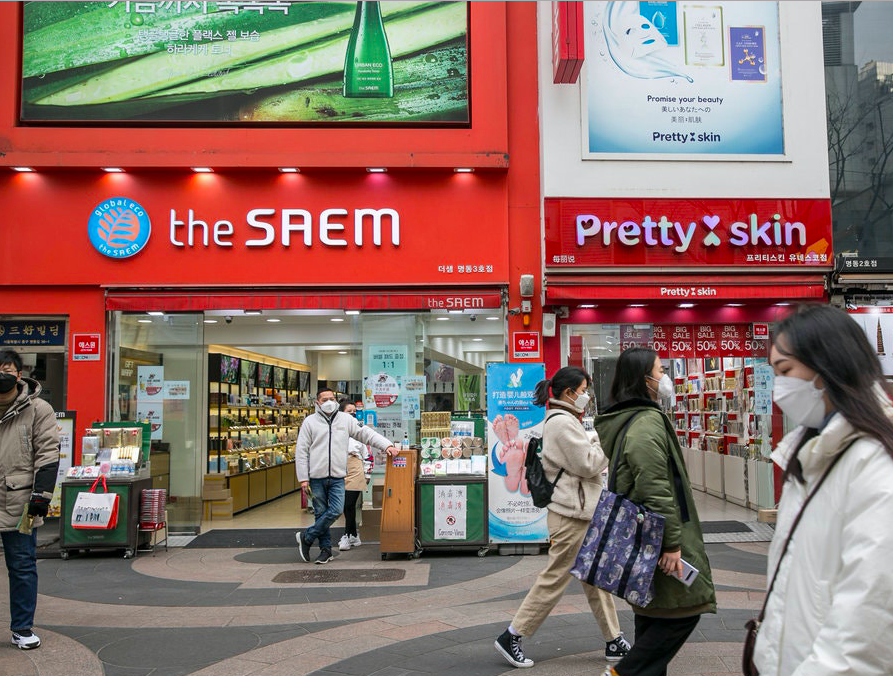South Korea and the United States experienced their first cases of the Coronavirus Disease 2019 (COVID-19) on the same day, Jan. 20. But while cases skyrocketed in the U.S., South Korea prevented the infection’s spread without economic or forcible shutdowns.
The number of new COVID-19 cases has hit a record high in the beginning of November as it rises 18% higher, with more than 575,000 people infected in the United States. Death rates have inched up to 3%, according to Reuters analysis of state and country reports. The number of increased cases has been the biggest in the last weeks of October, as health experts say deaths tend to increase four to six weeks after a surge in infections.
COVID-19 is a respiratory illness that can spread from person to person through coughs or sneezes, within about six feet. COVID-19 is a new disease that has not been seen in humans, and it has been spreading at a rapid pace since the beginning of 2020. Although most people with COVID-19 experience mild symptoms, the disease has led to the death of vulnerable people with chronic medical conditions or older adults.
As countries around the world wrestle with COVID-19, many Americans think the U.S should be learning from other countries about their responses in handling COVID-19, especially when it comes to preventing the spread. Americans largely agree that their country should look overseas, and beyond its borders to learn how to tackle this disease. Nearly half (46%) say the U.S can learn from other countries about handling the spread of the virus, while an additional 38% say the U.S can learn a fair amount. About 13% say there is not too much to learn. Furthermore, 3% say the U.S can learn nothing at all from other countries, according to an online survey conducted by the PEW Research center for adults.
When Lola Kim ‘24, was asked about her observation between the two countries, she stated, “Countries that are doing a better job and are more successful at keeping it [the number of cases] down should be something we can take away from…. if they’re doing really well, there has to be something in the system that’s keeping them (the number of cases) down.”
A patient in the United States was given a diagnosis of the first laboratory confirmed coronavirus case by the state of Washington and the US Centers for Disease Control and Prevention (CDC) on Jan. 20, and the laboratory officially reported it to the CDC on Jan. 22. Simultaneously, South Korea experienced its first confirmed COVID-19 case Jan. 20.
South Korea has managed to keep its death rate under 500 deaths as of Nov. 9, and is ranked number 90 in its total cases according to a live count recorded by the World O Meter. At the same time, America had the largest amount of coronavirus cases in the world with over 10.3 million cases and over 244,000 deaths as of Nov. 9.
Despite the fact that the South Korean population is just over 50 million people according to the United Nations as of Nov. 9, the U.S population is around 331 million, more than six times the population of South Korea.
-
Response from the US government
America’s response from the government regarding the beginning stages of coronavirus has led to the mass spread of the virus. Over the course of the past couple months, the Federal Government’s important official actions, communications and regulations have guided the public health challenge, according to the Brooking.Edu.
The First Phase: Our first knowledge of the case in Wuhan, China was treated as a minor threat that was under control, at least domestically, and the government assured the public that the risk of the virus was very low. Nonetheless, the virus spread overseas in several countries including Japan, China and South Korea in the middle of January. By the end of the month, the U.S had a handful of confirmed cases while China had 12,000 cases.
The Second Phase: Effective testing was going to be crucial and dependent on our testing capacity. Most health-care protective equipment is imported from countries such as China, therefore making equipment domestically cost more. Since the strike of the pandemic, the equipment from those manufacturers supplied their home country which left the U.S reliant on limited domestically manufactured resources. Although the resources are cost effective, the demands and expectations caused by the pandemic are too high. The days of relying on vertically-integrated companies such as Ford or General Motors have passed as technology has become more complex. Some states purchased non-certified masks from China, causing an uproar from the FDA. The FDA revealed the masks let in too many fine particles, thus being insufficient.
In early February, the administration and the CDC decided to rely exclusively on domestically developed tests. In contrast, German researchers developed their own tests which were distributed globally by the World Health Organization (WHO). Two weeks later the CDC tests kits proved to be faulty, as the tests delivered “inconclusive” readings. The kits sent to state laboratories were advised to not use them, as they were a failure. Additionally, alternative testings were ignored. Existing regulations from the Emergency Use Authorizations required by the Declaration of Public Health Emergency was meant to advance rapid testing. These required procedures lead to a massive delay of developing effective testing on a large scale.
The response from the CDC and the administration reassured state and local officials of its “adequate testing capacity” in late February, although it was reported that fewer than 500 tests had been conducted, according to CDC’s own count, plus those of U.S public health labs adds to around 4,000 tests by the end of Feb.
The failure to test at a large scale left the public recognizing the number of cases as low, which served as a reason for insisting that the testing kits were deficient. All of February, the second phase, became a critical month lost.
The Third Phase: By late February, the CDC widened its testing guidelines as the Food and Drug Administration allowed use of non-approved tests (with retroactive approval). On Feb. 29, the Federal Government communicated its awareness by placing travel bans extended to foreign nationalists in Iran, federal officials promoting responses from private districts and Congress passing an $8.6 billion supplemental appropriations bill. This includes emergency telehealth, the access of health care services remotely through digital information and communication along with promoting vaccine and treatment research and preparedness. Despite the administration insisting its satisfaction, testing was still limited even when it was expanding during this phase.
The Fourth Phase: President Donald Trump nationally televised a national emergency on March 13 regarding the Federal Government’s rapid actions to solve for COVID-19. Upon mass testing, improving the availability of medical supplies and the need for Americans to transform their behavior were the beginning attempts in preventing the spread of COVID-19. Further travel restrictions on foreign nationalists from continental Europe, the United Kingdom and Ireland took effect on March 16.
Emergency powers include the Defense Production Act, ultimately preventing others from hoarding needed supplies, performed by President Trump on March 13. Trump ordered The General Motors Company to produce ventilators and masks for the Federal Government, additionally Trump increased the government’s transparency by directing his administration to increase domestic production of essential products.
America’s shortages became more evident when hospitals and health systems lacked the ability to find existing supplies. In addition, America was deprived of a national tracking system for protective gear. Purchasers struggled to coordinate distribution of existing supply or anticipate future n
eeds as they blindly looked for available resources.
Efforts to improve the medical supply chain in the U.S requires a coordinated federal response. The Federal Government regulates distribution and pricing of purchased goods to prevent third-party buying or distribution to nonmedical providers.
Despite their efforts, the government has failed to proceed with those steps, and continues to endanger its citizens. The scarce amount of supplies and failure to disperse materials to states aids the potential pandemic waves in the future. Lacking the federal response, health systems continue to struggle to protect patients and health-care workers without their needed supplies.
Response from the South Korean Government:
-
Test Kits
While the United States urgently needed coronavirus test kits by mid-February, South Korea vigorously manufactured thousands of kits everyday. Korea’s post-MERS adjustments clarified South Korea’s roles of national and local governments, public health and industry sectors during another pandemic. MERS, the largest Middle Eastern Respiratory Syndrome coronavirus outbreak in South Korea occurred form May 2015 to July 2016. Sectors collaborated early and quickly during the first cases of COVID-19. Through the mass production of test kits and personal protective equipment (PPE) such as masks and gloves, it effectively protected high-risk cities during the early stages of the pandemic. With plentiful test kits public health officials had an easier time identifying COVID-19 cases.
By March 5, South Korea tested 145,000 people, more than the U.S., the U.K., France, Italy and Japan combined. To prevent hospitals from an overwhelming number of sick patients, Korean officials opened 600 testing centers with the use of drive-through testing stations. This fast food drive-through inspired the ten minute tests offered to patients in their cars to reduce face-to-face contact.
-
Highly correlated with contact tracing
Extensive testing availability set the successful stages for an important change: a legislation allowing the Korean Centers Disease Control and Prevention (KCDC) to use private data from 28 companies to trace the movement of infected patients with the virus. After tests confirm a positive case, officials use effective contact tracing and rapid identification. Officials use interviews, GPS phone tracking, credit-card records and video surveillance to trace an infected person’s travel history, reported by The Washington Post. The South Korean government publishes anonymous data about where each patient went before their diagnosis of the virus on a public website.
Lola Kim ‘24 stated, “It would really help in any situation, but I think especially in schools if you had symptoms….it would be really helpful to lessen the damage just in case anything bad were to happen.”
What’s more is that others can identify whether they have been near a patient. The report also described two smartphone apps providing the information of confirmed patients in the region, based on the information released by the KCDC. One app sets off an alarm when users are within a 100 meter distance of the location visited by a recently infected patient. The other app provides employees the safest routes to and from work without intersecting with infected individuals. Moreover, the government also used an app to monitor incoming traveler’s symptoms along with medical advice.
-
Self Isolation:
Once infected with the virus, South Korea divides the healthy from the sick and the somewhat sick from the really sick. Those with serious illnesses are sent straight to hospitals, while elderly patients are separated. Moderately sick people are sent to isolation dorms where they are monitored and the airborne disease cannot escape the room with the use of negative air pressure.
The asymptomatic contacts testing negative are asked to self-quarantine at home and use separate bathrooms, dishes and towels from others in their homes. Health service officials check daily to monitor their symptoms. International travelers must follow the two week self isolation policy and download the required app tracking their symptoms days after their arrival.
By early April South Korea reported that out of the 170,000 returning travelers to South Korea that had downloaded the app, around 9,000 people required a form of mandatory quarantine or hospitalization.
Jade Harris ‘24 said, “Yeah, I think that would be a good idea, especially to monitor people who travel a lot. I think that is smart especially if they go to highly infected countries.”
Past Outbreak Experience:
Back in 2002, the Severe Acute Respiratory Syndrome (SARS) outbreak killed several hundred people in East Asia. In 2009, the Swine Flu influenza killed several hundred South Koreans and more than 1 million people globally. South Korean public-health officials recognized the severity of these pandemic outbreaks, and proceeded with early testing and implementing isolation policies to prevent secondary infections. In 2015’s Middle East Respiratory Syndrome (MERS) created the basic guideline used to deal with COVID-19 today by South Korea.
Throughout the process the South Korean government made damaging mistakes before the spread of MERS. A lack of transparency from the government and unavailable testing kits along with information of the virus were severe mistakes made.
Although the United States has dealt with numerous outbreaks such as SARS, Zika and Ebola; COVID-19 has been the first time residents are experiencing a public-health emergency. In contrast, several democratic countries successfully fought against the virus, including South Korea. Bearing its scars from previous epidemics allowed the country to act quickly upon China’s first COVID-19 case released. Although the U.S government prides itself for being a, “great power competition,” it was not nearly prepared for the danger of this pandemic, leaving South Korea as an inspirational country to look up to.






